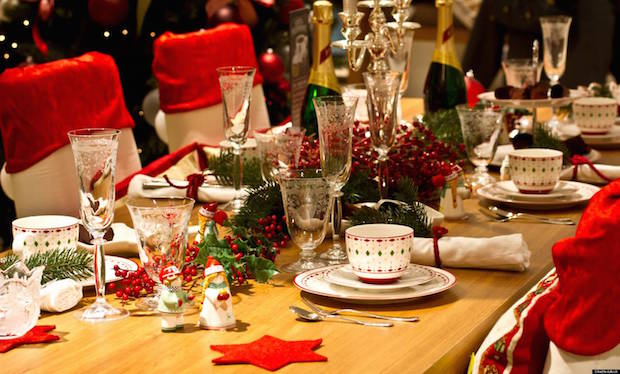Christmas Eve in France is a holiday in and of itself. Traditionally, it was celebrated with la Messe de Minuit (midnight mass) for many families, even those who are non-pratiquant (non-practicing). With attendance rates lowering, it’s becoming less and less common as a whole for the French to attend this mass, but you can still find them all over France.
Malgré son nom (despite its name), most of the masses take place between 6 and 10pm. Some people prefer to stay at home and watch the Pope’s Midnight Mass on France 2, and some even listen to local masses on the radio.

The Midnight Mass is followed by a large feast called le Réveillon (you might recognise la racine du mot [the root of the word]: comes from the same family as réveiller [to wake up / to revive]). Why this name? It’s to se réveiller (to wake yourself up) after such a late-night activity!
Ce festin (this feast) can be enjoyed at home or in a café or restaurant (some stay open all night for this). Even with all the food, depending on the region you’re in, the main dish may change. You might eat le poulet (chicken), les escargots (snails), la dinde farcie aux marrons (chestnut-stuffed turkey), le saumon fumé (smoked salmon), l’oie (goose), le boudin blanc (white pudding), ou même les huîtres (or even oysters). Naturally, all of this is washed down with le vin (wine) or/and le champagne (champagne).
So we decided to ask 3 people (two French and one Canadian French — le Réveillion exists there, too!) what their families do for Christmas Eve. Read their answers below (there are English translations but try reading the original French answers at the bottom of each post) and see how these families celebrate.
Can you see any similarities or differences?

Que fait votre famille pour le Réveillion de Noel?
Juliette, 24. Lille, France -
My family has never really been into celebrating Christmas Eve. For us, the party is on the 25th only, at a family member’s house. Thus, unless we were invited somewhere precisely to celebrate Christmas Eve, we would just stay at home.
When I was younger, I would spend the evening in my pajamas with my sister and my dad in front of the Christmas specials on TV, while my mom would prepare dinner and something 'special' like drinks (non-alcoholic champagne for children) and a small appetizer (toasts with salmon or fish eggs), or a Christmas party specialty (foie gras, smoked salmon, scallop). But since we had to be ready to host or leave early to go somewhere else the following day, that was it, especially since we must couldn’t eat too much, or we’d be sick for the big day!
However, in the past few years, the deal has changed: my sister is dating a Bulgarian guy, and because my parents don’t do anything, she often invites me over for a Bulgarian Christmas Eve: 12 home-made vegetarian courses (this is so that we can survive the 50 pounds or so of meat that would come the next day). We also open our presents at midnight.
Now, for Christmas Day, we stay very traditional when we host the party: appetizer, foie gras or salmon, turkey, chestnuts, salad, French chesse platter, and buche de Noel (the infamous French Christmas cake).
En Francias...
Ma famille n’a jamais été très 'réveillon de Noel'. Pour nous, la fête se fait le 25 décembre, chez un membre de la famille. Du coup, à moins d’être invités quelque part précisément pour le réveillon, on reste à la maison tranquillement.
Quand j’étais petite, je passais la soirée avec ma sœur et mon père, en pyjamas, à regarder les programmes de Noel et ma mère préparait quelque chose de 'spécial', comme un mini apéritif (champomy pour les enfants), avec des toasts au saumon ou aux œufs de Lymp, ou une entrée de fete (saumon fumé, foie gras, coquille Saint Jacques…) Mais comme il fallait etre pret à recevoir le lendemain ou prêt à partir tot pour aller chez la famille, c’était tout, d’autant plus qu’il ne fallait surtout pas avoir trop mangé et être malade !
Cependant, depuis quelques année, le programme a changé : ma sœur a maintenant un petit-ami bulgare, et puisque mes parents ne font rien, elle m’invite souvent pour un réveillon 100% Bulgare : 12 plats végétariens fait maison (histoire de survivre à la demi tonne de viande qui viendra lors du repas du 25). On ouvre également les cadeaux à minuit.
Maintenant, le jour de Noel, nous restons très traditionnels quand nous recevons : apéro, foie gras ou saumon, dinde, marrons, salade, fromage, et buche !
Olivier, 18. Montréal, Canada -
For Christmas, we generally celebrate the way our ancestors have since the French colonies. On the 24th, while some go hunting for the perfect Christmas tree, others prepare a typical French-Canadian Christmas dinner which includes :
– a stuffed turkey
– meatball stew
– ham
– pie
– baked beans
– potatoes
– cranberry sauce
– the French log cake
After supper, everyone plays games while listening to traditional music until midnight comes when everyone wishes a merry Christmas to their loved ones. For those who can’t wait, they’re allowed to open one gift from under the tree.
En Francias...
Chez nous, pour Noel, on perpétue certaines traditions qui datent de plusieurs générations, depuis le temps des grandes veillées des colons.
Le 24, alors qu’on va chercher un sapin pour décorer le salon, une ou plusieurs personnes s’occupe(nt) de préparer le souper du réveillon pour le restant de la famille qui ressemble à :
-une dinde farcie
-du ragout de boulettes
-du jambon
-une tourtière
-des fèves au lard
-des patates
-des atacas
-une buche de Noël
Après le souper, on passe la 'veillée' ensemble à jouer à des jeux en écoutant de la musique de Noel ou de la musique traditionnelle jusqu’à minuit et tout le monde se souhaite joyeux Noel. Pour ceux qui ne peuvent attendre, ils peuvent ouvrir un cadeau sous le sapin.
Karine, 24. Cavaillon, France -
The day before Christmas, that is to say December 24th, my family and I spend the most precious time of year together. It’s a warm time that we always choose to spend together, and we reserve the following days for the rest of my family, like my grandfather, for example. I know my friends do the same thing. However, what they don’t do is a tradition we invented! For weeks, my family and I carefully kept glass yogurt jars that we would wash out before putting candle in them that we’d light with a piece of spaghetti so we wouldn’t burn ourselves. When my sister and I were young, our parents told us that these little improvised lanterns that we’d place in the windows were used to help Santa Claus not get lost, and, of course, to not forget to come to us.
Now we continue this tradition with the yogurt jars because it’s our little bit of Christmas Magic. I prefer Christmas Eve. We eat all our favorite foods, and indisputably, the foie gras is in the spotlight! Right when we raise our glasses, my mom takes a picture of the family, and we toast in front of the nativity scene. My father puts on Christmas CDs, and we play with our dog. Even though we’re adults now, the gifts have to wait until the morning after Santa Claus has come. I cherish with all my heart these precious moments with my family because that’s the spirit of Christmas!
En Francias...
La veille de Noel, c’est-à-dire le 24 Décembre, ma famille et moi passons ensemble le moment le plus précieux de l’année. C’est un moment chaleureux que nous décidons de toujours passer ensemble, et nous réservons les jours qui suivent pour le reste de ma famille comme mon grand père par exemple. Je sais que mes amis font la même chose. En revanche, ce qu’ils ne font pas c’est notre tradition que nous avons inventé! Pendant des semaines ma famille et moi gardons précieusement des pots de yaourt en verre que nous avons au préalable nettoyé et où on installe une bougie que nous allumons à l’aide d’un spaghetti afin de ne pas nous bruler. Quand ma sœur et moi étions petites, nos parents nous disaient que ces petits photophores improvisés que nous plaçons aux fenêtres servaient à aider le Père Noël à ne pas se perdre, et bien sûr à ne pas oublier de venir chez nous.
Maintenant, nous perpétuons cette tradition des pots de yaourt, car c’est un peu notre magie de Noel à nous. Le réveillon est le moment que je préfère. Nous mangeons toutes les choses que nous préférons, et incontestablement; le foie gras est à l’honneur! Au moment de lever nos verres, ma mère prend une photo de famille, puis nous trinquons devant la crèche. Mon père met des CD de Noël, nous jouons avec notre chien. Meme si nous sommes grandes maintenant, les cadeaux attendront demain matin, le temps que le Père Noel passe. Je chérie de tout mon coeur ces instants précieux avec ma famille, car c’est aussi ça l’esprit de Noël.
What does your family do for Christmas Eve?
Does your family celebrate Christmas Eve? How so?
Any similarities between your family’s celebrations and Olivier’s, Juliette’s, or Karine’s?

Blog submitted by: Alex at The French Property Network - Cle France.
This blog was originally posted on The French Language Blog pages.